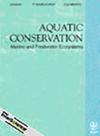Hypselobarbus curmuca is an endemic fish species of Family Cyprinidae found in rivers and reservoirs of the Western Ghats, India. An interdisciplinary study was conducted to assess the population genetic structuring of the species with the help of conventional morphometric, image-based truss network and genomic data of a nonprotein encoding mitochondrial DNA region (partial D-loop −494 bp) (n = 106). Fishes were collected from five rivers of the Western Ghats, namely, Kali, Sharavathi and Chalakudy (west-flowing) and Ghod and Tungabhadra (east-flowing) (n = 294). Multivariate analysis of body measurements and truss distances revealed very weak separation among populations. The D-loop sequence analysis showed that genetically distinct populations of fishes inhabit the studied rivers. Principal component analysis (PCA) and linear discriminant analysis (LDA) could not completely distinguish morphologically distinct populations. D-loop sequence analysis indicated 13 haplotypes with low nucleotide diversity and 15 polymorphic sites, with location-specific haplotypes. An overall haplotype diversity of 0.80 and nucleotide diversity of 0.00849 were found. The haplotype network and maximum likelihood phylogenetic tree showed three clusters with two most probable ancestors. Analysis of molecular variance (AMOVA) showed a high value (0.898) of the fixation index (FST) among the populations (p > 0.05). Neutrality test and mismatch distribution results indicated that the populations are currently subjected to selection. Application of an integrated approach to characterise the populations of H. curmuca in the wild supports the hypothesis of geographical barriers as major drivers of population genetic differentiation. Different riverine environments have not selected for morphological differences during the evolutionary process in the recent past and showed weak separation of populations. These findings can be utilised while designing conservation strategies for the species in the rivers of the Western Ghats, as the species faces threats due to exploitation in capture fisheries and trade in aquaculture.


